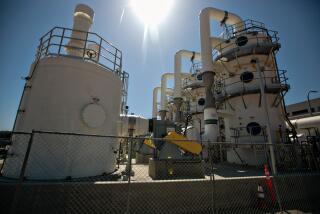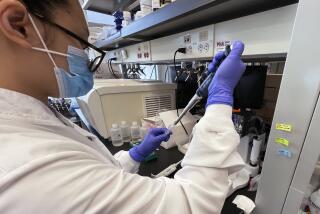Homeland Security replacing troubled biodefense system with another flawed approach
Reporting from Washington â The Trump administration is quietly moving to replace BioWatch, the nationâs problem-plagued system for detecting an airborne attack of anthrax spores or other infectious agents, with technology that also has severe shortcomings, a Times investigation has found.
The first new device was installed without public notice in December and others are being emplaced at 11 other U.S. locations with a goal of supplanting BioWatch âwithin the next couple of years,â James F. McDonnell, an assistant secretary of Homeland Security, said in an interview.
McDonnell, who heads Homeland Securityâs office of countering weapons of mass destruction, said the new system, called BioDetection 21, will be faster and more reliable than BioWatch. He said he hopes to put as many as 9,000 new detection devices in place by 2025.
But testing at an Army facility last year and use of the sensing devices in previous military operations identified critical problems with their ability to detect the bacteria, viruses or toxins that might be wielded in an attack, according to scientific experts and official documents.
BioWatch was hurriedly installed after the 9/11 terrorist attacks of 2001 in an effort to provide a quick, dependable warning system in the event, however unlikely, of the deliberate spread of anthrax, smallpox or other deadly pathogens. Authorities could then respond with antibiotics, vaccines, quarantines or other emergency measures to minimize casualties.
However, BioWatch generated scores of disruptive false alarms, including in Los Angeles, Pasadena and San Diego, and scientists have warned that the system â which has cost $1.6 billion so far â is not reliable.
The new system will depend on so-called trigger devices that use fluorescent light to identify potentially dangerous biological material in the air. Once the devices trigger a warning, officials would seek confirmation with handheld equipment.
But a lengthy report last fall, commissioned by Homeland Securityâs scientific staff, warned that the trigger devices frequently canât distinguish between deadly pathogens and airborne pollen or paper dust, increasing the likelihood of false alarms.
The report also showed that four trigger devices failed in testing last year to detect tiny, unclumped anthrax spores â the type that experts say a skilled terrorist or state-sponsored biowarfare program might produce.
Moreover, the triggers correctly detected small particles of viral material â simulating smallpox or other deadly viruses that could be weaponized â in just eight of 168 attempts, a success rate of less than 5%.
Trigger devices have âclear limitations ⌠for detection of smaller particles and some biological threat categories,â the report said.
The Times obtained a copy of the report, which was produced by the Johns Hopkins University Applied Physics Laboratory. The findings were consistent with Homeland Securityâs earlier evaluations of triggers, according to current and former federal scientists.
The new report also recommended against using the handheld devices, called biological identifiers, that would be used to confirm or dispel a trigger alert under BioDetection 21.
It cited the cost and utility of the devices, saying civilian officials would not order an evacuation or other major emergency response without taking additional time to verify an attack through genetic testing at a laboratory.
Given the drawbacks of the triggers and handheld identifiers, Homeland Security risks replacing BioWatch with a system that would be even less useful, according to several current and former government scientists who have led federal efforts to improve biodetection.
âThe technology hasnât evolved to the point where it would be an effective replacementââ for BioWatch, said Stephen A. Morse, a microbiologist who worked for 32 years at the U.S. Centers for Disease Control and Prevention.
Trigger devices, he said in an interview, âdonât detect small particle sizes. They donât detect low concentrations of particles.â
Morse and other experts said the triggers would struggle with fine-powdered anthrax and would not reliably detect low volumes of the bacterium that causes tularemia, another potential biowarfare agent. Known as rabbit fever, tularemia can set in after inhaling just 10 to 50 particles of the bacteria, compared with 8,000 to 50,000 anthrax spores needed to cause that disease.
McDonnell said the test results in the Johns Hopkins report âraise concerns,â but he believes problems will be resolved as BioDetection 21 is rolled out.
âPart of what Iâm sort of reining in the scientists a little bit on is, âDonât let perfection be the enemy of good enough,ââ he said.
McDonnell said he is âcertainly concernedâ that too many false alarms could undermine public confidence.
But he said he âprobablyâ would seek to close a major public facility, such as Pennsylvania Station in New York, the busiest passenger rail hub in America, if one of the new devices triggered a warning and the handheld equipment confirmed a dangerous pathogen.
Additional verification through genetic testing at a lab would be necessary to administer medicines, he said.
McDonnell estimated the new system could detect and confirm infectious agents in less than three hours. BioWatch was designed to produce such results in 12 to 36 hours.
He also is seeking better computing capability that might help the new system distinguish between benign and dangerous material, he said.
The first trigger device was installed Dec. 22 and another will be added this month, McDonnell said, adding that he has funds set aside to pay for all 12 sites. He declined to identify them.
McDonnell said he aims to keep the new systemâs operating cost to $80 million a year, the same as BioWatch now costs.
The triggers intended for the new system were tested last May and June at the Armyâs Edgewood Chemical Biological Center in Maryland, according to the Johns Hopkins report.
The military has used trigger devices for years in the Middle East and South Korea to detect possible biological attacks â and false alarms have been common.
When those triggers signal an attack, troops put on masks and protective suits to block ingestion or skin contact with airborne bio-agents. If itâs a false alarm, the troops remove the gear and resume their duties.
The military accepts the false alarms as the price for using a portable, if imperfect, detection system. In a busy city or crowded stadium, a false alarm â and the sight of emergency responders in moon suits â could create panic.
âIn the military, you can always live with an occasional false alarm,ââ said Stephen Reeves, a retired Army major general whose staff developed the air-sampling technique used for BioWatch. âYou canât deal with that with the public.ââ
The threat of an intentional biological release has loomed for decades. The United States renounced its offensive biowarfare program in 1969, but officials suspect some adversaries and terrorist groups have continued efforts to weaponize pathogens.
Fears soared several weeks after the 9/11 attacks, when letters laced with anthrax spores killed five people, infected 17 others and forced the closure of numerous government buildings and U.S. mail facilities.
The FBI ultimately concluded that the culprit was Bruce E. Ivins, an Army microbiologist who was an anthrax specialist at Ft. Detrick, Md. Ivins killed himself in July 2008 after he learned he was about to be indicted for the anthrax deaths.
Soon after the letter attacks, BioWatch was being installed around the country. Placed at street level or atop buildings, the systemâs compact sensors suck air through filter cartridges intended to trap any suspect material.
Once a day, the used filter is replaced by a technician and taken to a local laboratory that uses genetic testing to search for BioWatch-targeted pathogens.
Although the George W. Bush administration assured Congress that BioWatch was working smoothly, it proved problematic from the start.
In July 2012, The Times disclosed that BioWatch had falsely warned of scores of attacks through 2008, including at high-profile public events.
On Aug. 28, 2008, for example, Barack Obamaâs acceptance speech at the Democratic National Convention in Denver was jeopardized by BioWatchâs false warning of tularemia at the site.
After six hours of tense deliberations, including conference calls between the White House, Homeland Security headquarters and state health officials in Denver, Colorado authorities concluded that no attack had occurred.
âWhat we had in Denver was a false positive,ââ Chris Lindley, who headed the stateâs emergency response, recalled recently. âHundreds of people sat around rooms and debated and talked about how we would respond, how we would quarantine, how we would administer [antibiotics]. All that was just wasted time.ââ
In 2015, a report by the Government Accountability Office, which conducts investigations and audits for Congress, identified 149 false alarms by BioWatch. In each case, officials at the scene ultimately decided the system was at fault.
At an industry-sponsored biodefense conference in Washington last Nov. 14, three former top U.S. officials publicly repudiated the system they had helped launch.
âNone of us really believeâ in BioWatch, said Tom Ridge, who oversaw its installation in 2003 as the first secretary of Homeland Security.
âI had such high expectationsâ for BioWatch, said Tom Daschle, who was Senate majority leader when an anthrax-laced letter was opened at his office in October 2001. âAnd I must say, Iâm very disappointed with what has happened since.ââ
âAfter 2001, we really rushed to get things in place, including BioWatch,â said Joe Lieberman, the former senator from Connecticut who chaired the Senate Homeland Security Committee. The system ânever fully delivered on our hopes for it.â
Lieberman asked McDonnell whether switching to BioDetection 21 âwill really bring us as close to up to date as we can â and have a much more effective system than BioWatch?ââ
McDonnell replied, âYes, sir.â
More to Read
Get the L.A. Times Politics newsletter
Deeply reported insights into legislation, politics and policy from Sacramento, Washington and beyond. In your inbox three times per week.
You may occasionally receive promotional content from the Los Angeles Times.











